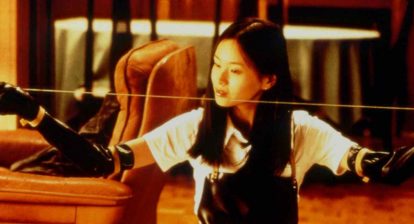“He always wanted to be a Yakuza, ever since he was a little boy” an unidentified interviewee says as a montage of black and white photos of future Yakuza Rikio Ishikawa (Tetsuya Watari) plays near the beginning of Kinji Fukasaku’s Graveyard of Honor. Filmed in 1975, it predates Goodfellas, which opens with Ray Liotta’s Henry Hill saying, “As far back as I can remember, I always wanted to be a gangster” by fifteen years. It seems likely that Goodfellas director Martin Scorsese took inspiration from the original Graveyard of Honor.
Both films were inspired by the lives of actual gangsters. In the case of Graveyards of Honor, Fukasaku (who also directed the classic Battle Royale), the inspiration was a novel based on the real life Ishikawa (while Goodfellas is based on a non-fiction book chronicling the life of Hill). The two films diverge in their narrative structures. Scorsese incorporates the elements of a tragedy, focusing on how Hill’s fatal flaw eventually leads to his tragic downfall. Fukasaku and screenwriter Tatsuhiko Kamoi’s film tries to answer a question asked in the aforementioned opening interviews: “What turned this young man into a rabid dog?”
RELATED: The Anger Games: Why Battle Royale is Still Relevant Today
In that respect, Graveyard of Honor has much more in common with Henry: Portrait of a Serial Killer than any American gangster films. Ishikawa, like Henry, is a bad man. He robs, rapes, stabs, shoots, and murders without discrimination, or as he puts it, “raising hell” in post-war Japan. While the other Yakuza members try to hold themselves to a code of honor, Ishikawa gives into his darkest impulses, seemingly as soon as he has them.
The film is chaotic because of his impetuousness, and the cinematography reflects that. One early scene features Ishikawa having a relatively mundane conversation sitting on the floor while topless women are chased in circles by his fellow Yakuza. The men and women streak in front of the camera, blocking our view of Ishikawa. The fights are equally tumultuous, with the camera zoomed in so close it’s hard to tell whose fist is connecting with whose jaw before there’s another quick cut. That kind of cinematography can be annoying, but in Graveyard of Honor it matches the images to Ishikawa’s interior landscape.

It’s certainly not a fun film, and it ends with a strong condemnation of Ishikawa’s violent behavior. Takashi Miike’s 2002 reimagining, the other half of this collection, follows the same structure but updates the story to take place in the late 1990s.
While Miike emulates Fukasaku’s choppy cinematography during fight scenes, he takes things a step further. In the 1975 version of Graveyards of Honor, Fukasaku was happy to cut away from the most violent moments. Anyone familiar with Miike knows that he’s not one to let viewers go so easily. His version of Graveyard of Honor was filmed in between Audition and Ichi the Killer, and it has a prison escape sequence grosser than anything in those two notoriously violent films.
Despite that, Fukasaku’s is the more disturbing of the two films. Even though it turns away the most violent moments, it does less to humanize the lead, who Miike renamed Rikuo Ishimatsu (Goro Kishitani). Screenwriter Shigenori Takechi adds more to Ishimatsu’s life and Kishitani plays the character with more charm, making him feel less dangerous.
RELATED: First Love is Snatch with Sword Fights [Blu-Ray Review]
Both versions of the film fail Chieko (played by Yumi Takigawa in 1975 and Narimi Arimori in 2002). In both, the lead character assaults her early on, and then simply doesn’t stop showing up at her apartment until they’re married. This kind of writing is two-dimensional, robbing her of her agency. It’s not her story and it doesn’t need to be, but if she’s to be believed as a character, she needs to make a choice or demonstrate how she feels about not having one.
Having both films in a single pack is excellent. It allows viewers to watch two virtuoso filmmakers tell the same story back to back. The collection is also chock full of special features. There are commentary tracks for both films, and a series of documentaries, detailing the making, reception, and cultural impact these films had. They’re packaged in a beautiful case with original artwork by Ian MacEwan.

Wicked Rating – 8.5/10
The Graveyards of Honor collection is available from Arrow Video now.





